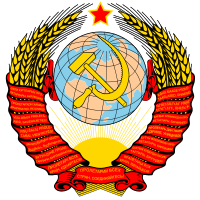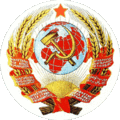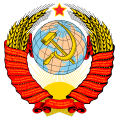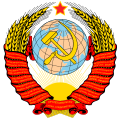- State Emblem of the Soviet Union
-
"State Emblem of the USSR" and "Coat of arms of the USSR" redirect here. For other uses, see State Emblem of the USSR (disambiguation) and Coat of arms of the USSR (disambiguation).
State Emblem of the Union of Soviet Socialist Republics 
Details Armiger  Government of the
Government of the
Union of Soviet Socialist RepublicsAdopted 6 July 1923 Escutcheon Globe; Hammer and Sickle Supporters Ears of wheat Motto Workers of the world, unite! Other elements Red star, Rising sun The State Emblem of the Soviet Union (Russian: Государственный герб СССР Gosudarstvennyiy gerb SSSR[1]) was adopted in 1923 and was used until the dissolution of the Soviet Union in 1991. Although it technically is an emblem rather than a coat of arms, since it does not follow heraldic rules, in Russian it is called герб (transliteration: gerb), the word used for a traditional coat of arms.
Contents
History
First version (1923–1936)
The project of the first version of the state emblem was accepted on July 6, 1923 by the 2nd session of the Central Executive Committee (CIK) of the USSR and the version was completed on September 22 of that year.[2] This design was fixed in the 1924 Soviet Constitution:"The State Emblem of the USSR is composed of a sickle and a hammer on a globe depicted in the rays of the sun and framed by ears of wheat, with the inscription "proletariats of the world, unite!" in six languages - Russian, Ukrainian, Belarusian, Georgian, Armenian, Turko-Tatar. At the top of the Emblem is a five-pointed star."
Ivan Dubasov was an important contributor when creating the emblem.
Second version (1936–1946)
According to the 1936 Soviet Constitution, the USSR consisted of eleven republics. Hence the major new version's difference from the previous one were eleven ribbons bearing USSR State Motto inscriptions in eleven languages.
Third version (1946–1956)
The number of republics in the USSR became 16 after September 1939, and before the Great Patriotic War began in June 1941, but the state emblem was changed to reflect this only after the war. By a Decision of Presidium of the Supreme Soviet of the USSR of June 26, 1946, all 16 constituent republics were represented on the emblem. The USSR State Motto was inscribed on 16 ribbons in 16 languages (Estonian, Latvian, Lithuanian, Moldavian, Finnish languages were added to the previous version). Inscriptions in Azerbaijani, Turkmen, Uzbek, Tajik, Kazakh, Kyrgyz languages were updated due to the transfer from the Latin alphabet to Cyrillic alphabet of respective republics.[2]
Fourth version (1956–1991)
In 1956 Karelo-Finnish SSR was transformed into Karelo-Finnish ASSR and soon this was reflected on the USSR state emblem.[2] By a Decision of Presidium of the Supreme Soviet of the USSR of September 12, 1956, a ribbon bearing the USSR State Motto in Finnish was removed.[3]
One more minor change was introduced into the USSR State Motto in Belarusian language by a Decision of the Presidium of Supreme Soviet of the USSR of April 1, 1958.[3]
Inscriptions on ribbons (which are translated into English as "Proletarians of the world, unite!") are as follows:
Left Right Turkmen: Әхли юртларың пролетарлары, бирлешиң! Estonian: Kõigi maade proletaarlased, ühinege! Tajik: Пролетарҳои ҳамаи мамлакатҳо, як шавед! Armenian: Պրոլետարներ բոլոր երկրների, միացե'ք! Latvian: Visu zemju proletārieši, savienojieties! Kyrgyz: Бардык өлкөлөрдүн пролетарлары, бириккиле! Lithuanian: Visų šalių proletarai, vienykitės! Moldavian: Пролетарь дин тоатe цериле, уници-вэ! Georgian: პროლეტარებო ყველა ქვეყნისა, შეერთდით! Azerbaijani: Бүтүн өлкәләрин пролетарлары, бирләшин! Uzbek: Бутун дунё пролетарлари, бирлашингиз! Kazakh: Барлық елдердің пролетарлары, бірігіңдер! Ukrainian: Пролетарі всіх країн, єднайтеся! Belarusian: Пралетарыі ўсіх краін, яднайцеся! Russian: Пролетарии всех стран, соединяйтесь! Description
The state emblem shows the traditional Soviet emblems of the hammer and sickle and the Red Star over a globe, and two wreaths of wheat covered by the USSR State motto ("Workers of the World, Unite!") in the official languages of the Soviet Republics, in the reverse order they were mentioned in the Constitution of the Soviet Union.
Each Soviet Republic (SSR) and Autonomous Soviet Republic (ASSR) had its own coat of arms, largely inspired by the state emblem of the Union.
Gallery
See also
References
- ^ Ukrainian: Державний герб СРСР; Belarusian: Дзяржаўны герб СССР; Kazakh: ССРО мемлекеттік елтаңбасы; Lithuanian: TSRS Valstybinis herbas; Latvian: PSRS valsts ģerbonis; Estonian: NSVL riigivapp
- ^ a b c Bolotina, S. (November 1983). "How Our State Emblem Was Created" (in Russian). Nauka i Zhizn: pp. 20–24. ISSN 0028-1263.
- ^ a b (Russian) Герб СССР
 Coats of arms of the Soviet Union and Soviet RepublicsCoat of arms of the Union of Soviet Socialist Republics
Coats of arms of the Soviet Union and Soviet RepublicsCoat of arms of the Union of Soviet Socialist Republics Armenian SSR · Azerbaijan SSR · Byelorussian SSR · Estonian SSR · Georgian SSR · Kazakh SSR · Kirghiz SSR · Latvian SSR · Lithuanian SSR · Moldavian SSR · Russian SFSR · Tajik SSR · Turkmen SSR · Ukrainian SSR · Uzbek SSRCategories:
Armenian SSR · Azerbaijan SSR · Byelorussian SSR · Estonian SSR · Georgian SSR · Kazakh SSR · Kirghiz SSR · Latvian SSR · Lithuanian SSR · Moldavian SSR · Russian SFSR · Tajik SSR · Turkmen SSR · Ukrainian SSR · Uzbek SSRCategories:- Coats of arms of former countries
- Coats of arms of the Soviet Union
- National symbols of the Soviet Union
- National emblems
Wikimedia Foundation. 2010.



